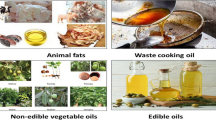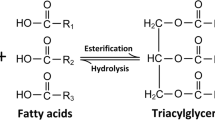Abstract
An organic solvent-stable lipase from Proteus vulgaris K80 was used to produce the omega-3 polyunsaturated fatty acid ethyl esters (ω-3 PUFA EEs). First, the lyophilized recombinant lipase K80 (LyoK80) was used to perform the transesterification reaction of menhaden oil and ethanol. LyoK80 produced the ω-3 PUFA EEs with a conversion yield of 82 % in the presence of 20 % water content via a three-step ethanol-feeding process; however, in a non-aqueous condition, LyoK80 produced only a slight amount of the ω-3 PUFA EEs. To enhance its reaction properties, the lipase K80 was immobilized on a hydrophobic bead to derive ImmK80; the biochemical properties and substrate specificity of ImmK80 are similar to those of LyoK80. ImmK80 was then used to produce ω-3 PUFA EEs in accordance with the same transesterification reaction. Unlike LyoK80, ImmK80 achieved a high ω-3 PUFA EE conversion yield of 86 % under a non-aqueous system via a one-step ethanol-feeding reaction. The ω-3 PUFA EEs were purified up to 92 % using a urea complexation method.





Similar content being viewed by others
References
Calder, P. C. (2014). Very long chain omega‐3 (n‐3) fatty acids and human health. European Journal of Lipid Science and Technology, 116, 1280–1300.
Eilander, A., Hundscheid, D. C., Osendarp, S. J., Transler, C., & Zock, P. L. (2007). Effects of n-3 long chain polyunsaturated fatty acid supplementation on visual and cognitive development throughout childhood: a review of human studies. Prostaglandins, Leukotrienes and Essential Fatty Acids, 76, 189–203.
Labrousse, V. F., Nadjar, A., Joffre, C., Costes, L., Aubert, A., Gregoire, S., Bretillon, L., & Layé, S. (2012). Short-term long chain omega3 diet protects from neuroinflammatory processes and memory impairment in aged mice. PLoS One, 7, e36861.
Mori, T. A., & Woodman, R. J. (2006). The independent effects of eicosapentaenoic acid and docosahexaenoic acid on cardiovascular risk factors in humans. Current Opinion in Clinical Nutrition & Metabolic Care, 9, 95–104.
Russell, F. D., & Bürgin-Maunder, C. S. (2012). Distinguishing health benefits of eicosapentaenoic and docosahexaenoic acids. Marine drugs, 10, 2535–2559.
Hjaltason, B., & Haraldsson, G. G. (2006). Use of fish oils and marine PUFA concentrates. In F. Gunstone (Ed.), Modifying lipids for use in food (pp. 587–602). Woodhead Publishing Limited: Cambridge.
Homayooni, B., Sahari, M. A., & Barzegar, M. (2013). Concentrations of omega-3 fatty acids from rainbow sardine fish oil by various methods. International Food Research Journal, 21, 743–748.
Patil, D. (2014). Recent trends in production of polyunsaturated fatty acids (PUFA) concentrates. Journal of Food Research and Technology, 2, 15–23.
Rubio-Rodríguez, N., Beltrán, S., Jaime, I., Sara, M., Sanz, M. T., & Carballido, J. R. (2010). Production of omega-3 polyunsaturated fatty acid concentrates: a review. Innovative Food Science and Emerging Technologies, 11, 1–12.
Tengku-Rozaina, T. M., & Birch, E. J. (2013). Enrichment of omega-3 fatty acids of refined hoki oil. Journal of the American Oil Chemists' Society, 90, 1111–1119.
Fernández-Lorente, G., Betancor, L., Carrascosa, A. V., & Guisán, J. M. (2011). Release of omega-3 fatty acids by the hydrolysis of fish oil catalyzed by lipases immobilized on hydrophobic supports. Journal of the American Oil Chemists' Society, 88, 1173–1178.
Valverde, L. M., Moreno, P. A. G., Cerdán, L. E., López, E. N., López, B. C., & Medina, A. R. (2014). Concentration of docosahexaenoic and eicosapentaenoic acids by enzymatic alcoholysis with different acyl-acceptors. Biochemical Engineering Journal, 91, 163–173.
Zheng, M. M., Dong, L., Lu, Y., Guo, P. M., Deng, Q. C., Li, W. L., Feng, Y. Q., & Huang, F. H. (2012). Immobilization of Candida rugosa lipase on magnetic poly (allyl glycidyl ether-co-ethylene glycol dimethacrylate) polymer microsphere for synthesis of phytosterol esters of unsaturated fatty acids. Journal of Molecular Catalysis B: Enzymatic, 74, 16–23.
Iyer, P. V., & Ananthanarayan, L. (2008). Enzyme stability and stabilization—aqueous and non-aqueous environment. Process Biochemistry, 43, 1019–1032.
Singh, R. K., Tiwari, M. K., Singh, R., & Lee, J. K. (2013). From protein engineering to immobilization: promising strategies for the upgrade of industrial enzymes. International journal of molecular sciences, 14, 1232–1277.
Moreno-Pérez, S., Guisan, J. M., & Fernandez-Lorente, G. (2014). Selective ethanolysis of fish oil catalyzed by immobilized lipases. Journal of the American Oil Chemists' Society, 91, 63–69.
Shimada, Y., Watanabe, Y., Sugihara, A., Baba, T., Ooguri, T., Moriyama, S., Terai, T., & Tominaga, Y. (2001). Ethyl esterification of docosahexaenoic acid in an organic solvent-free system with immobilized Candida antarctica lipase. Journal of bioscience and bioengineering, 92, 19–23.
Kim, H. K., Lee, J. K., Kim, H., & Oh, T. K. (1996). Characterization of an alkaline lipase from Proteus vulgaris K80 and the DNA sequence of the encoding gene. FEMS microbiology letters, 135, 117–121.
Yoon, S. A., Han, J. Y., & Kim, H. K. (2011). Production of biodiesel using immobilized lipase from Proteus vulgaris. Korean Journal of Microbiology and Biotechnology, 39, 238–244.
Kim, S. H., Kim, S. J., Park, S., & Kim, H. K. (2013). Biodiesel production using cross-linked Staphylococcus haemolyticus lipase immobilized on solid polymeric carriers. Journal of Molecular Catalysis B: Enzymatic, 85, 10–16.
Teng, Y., & Xu, Y. (2007). A modified para-nitrophenyl palmitate assay for lipase synthetic activity determination in organic solvent. Analytical Biochemistry, 363, 297–299.
Wanasundara, U. N., & Shahidi, F. (1999). Concentration of omega 3-polyunsaturated fatty acids of seal blubber oil by urea complexation: optimization of reaction conditions. Food Chemistry, 65, 41–49.
Adlercreutz, P. (2013). Immobilisation and application of lipases in organic media. Chemical Society Reviews, 42, 6406–6436.
Liu, J., Deng, L., Wang, M., Nie, K., Liu, L., Tan, T., & Wang, F. (2014). Lipase catalyzed synthesis of medium-chain biodiesel from Cinnamonum camphora seed oil. Chinese Journal of Chemical Engineering, 22, 1215–1219.
No, D. S., Zhao, T. T., Kim, Y., Yoon, M. R., Lee, J. S., & Kim, I. H. (2015). Preparation of highly purified pinolenic acid from pine nut oil using a combination of enzymatic esterification and urea complexation. Food Chemistry, 170, 386–393.
Shah, S., & Gupta, M. N. (2007). Lipase catalyzed preparation of biodiesel from Jatropha oil in a solvent free system. Process Biochemistry, 42, 409–414.
Sheldon, R. A. (2007). Enzyme immobilization: the quest for optimum performance. Advanced Synthesis & Catalysis, 349, 1289–1307.
Dizge, N., Keskinler, B., & Tanriseven, A. (2008). Covalent attachment of microbial lipase onto microporous styrene–divinylbenzene copolymer by means of polyglutaraldehyde. Colloids and Surfaces B: Biointerfaces, 66, 34–38.
Garg, N., & Kumar, A. (2008). Immobilization of starch phosphorylase from cabbage leaves: production of glucose-1-phosphate. Brazilian Journal of Chemical Engineering, 25, 229–235.
Shah, S., Solanki, K., & Gupta, M. N. (2007). Enhancement of lipase activity in non-aqueous media upon immobilization on multi-walled carbon nanotubes. Chemistry Central Journal, 1, 1–6.
Herbst, D., Peper, S., & Niemeyer, B. (2012). Enzyme catalysis in organic solvents: influence of water content, solvent composition and temperature on Candida rugosa lipase catalyzed transesterification. Journal of biotechnology, 162, 398–403.
Selmi, B., & Thomas, D. (1998). Immobilized lipase-catalyzed ethanolysis of sunflower oil in a solvent-free medium. Journal of the American Oil Chemists' Society, 75, 691–695.
Su, F., Li, G., Zhang, H., & Yan, Y. (2014). Enhanced performance of Rhizopus oryzae lipase immobilized on hydrophobic carriers and its application in biorefinery of rapeseed oil deodorizer distillate. BioEnergy Research, 7, 935–945.
Acknowledgments
This work was supported by the National Research Foundation of Korea (NRF) grant funded by the Korea government (MSIP) (2014R1A2A2A01006978) and by the Research Fund 2015 of The Catholic University of Korea.
Author information
Authors and Affiliations
Corresponding author
Rights and permissions
About this article
Cite this article
Kim, Sj., Kim, H.K. Production of Omega-3 Fatty Acid Ethyl Esters from Menhaden Oil Using Proteus vulgaris Lipase-Mediated One-Step Transesterification and Urea Complexation. Appl Biochem Biotechnol 179, 347–360 (2016). https://doi.org/10.1007/s12010-016-1998-7
Received:
Accepted:
Published:
Issue Date:
DOI: https://doi.org/10.1007/s12010-016-1998-7




